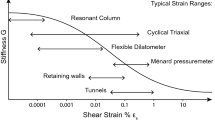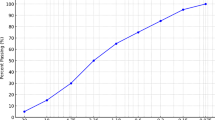Abstract
In the last two decades, small strain shear modulus became one of the most important geotechnical parameters to characterize soil stiffness. Finite element analysis have shown that in-situ stiffness of soils and rocks is much higher than what was previously thought and that stress-strain behaviour of these materials is non-linear in most cases with small strain levels, especially in the ground around retaining walls, foundations and tunnels, typically in the order of 10−2 to 10−4 of strain. Although the best approach to estimate shear modulus seems to be based in measuring seismic wave velocities, deriving the parameter through correlations with in-situ tests is usually considered very useful for design practice.The use of Neural Networks for modeling systems has been widespread, in particular within areas where the great amount of available data and the complexity of the systems keeps the problem very unfriendly to treat following traditional data analysis methodologies. In this work, the use of Neural Networks and Support Vector Regression is proposed to estimate small strain shear modulus for sedimentary soils from the basic or intermediate parameters derived from Marchetti Dilatometer Test. The results are discussed and compared with some of the most common available methodologies for this evaluation.







Similar content being viewed by others
Explore related subjects
Discover the latest articles, news and stories from top researchers in related subjects.References
Clayton C, Heymann G (2001) Stiffness of geomaterials at very small strains. Géotechnique 51(3):245–255
Fahey M (2001) Soil stiffness values for foundation settlement analysis. In: Balkema L (ed) Proceedings 2nd international conference on pre-failure deformation characteristics of geomaterials, vol 2, pp 1325–1332
Peck R, Hanson W, Thornburn T (1974) Foundation engineering, 2nd edn. Wiley
Lunne T, Robertson P, Powell J (1997) Cone penetration testing in geotechnical practice. Spon E & F N
Marchetti S (1980) In-situ tests by flat dilatometer. J Geotechn Eng Div 106 (GT3):299–321
Cruz N, Devincenzi M, Viana da Fonseca A (2006) Dmt experience in iberian transported soils. In: Proceedings 2nd international flat dilatometer conference, pp 198–204
Cruz N (2010) Modelling geomechanics of residual soils by DMT tests, PhD thesis, Universidade do Porto
Marchetti S (1997) The flat dilatometer: design applications. In: Third geotechnical engineering conference Cairo University
Mayne P (2006) Interrelationships of dmt and cpt in soft clays. In: Proceedings 2nd international flat dilatometer conference, pp 231–236
Hryciw R (1990) Small-strain-shear modulus of soil by dilatometer. J Geotech Eng ASCE 116(11):1700–1716
Hardin B, Blandford G (1989) Elasticity of particulate materials. J Geotech Eng Div 115(GT6):788–805
Jamiolkowski B, Ladd C, Jermaine J, Lancelota R (1985) New developments in field and laboratory testing of soilsladd, c.c. In: XI ISCMFE, vol 1, pp 57–153
Sully J, Campanella R (1989) Correlation of maximum shear modulus with dmt test results in sand. In: Proceedings XII ICSMFE, pp 339–343
Tanaka H, Tanaka M (1998) Characterization of sandy soils using CPT and DMT. Soils Found 38(3):55–65
Marchetti S, Monaco P, Totani G, Marchetti D (2008) From research to practice in geotechnical engineering D.K. Crapps, volume 180, chapter In -situ tests by seismic dilatometer (SDMT). ASCE Geotech Spec. Publ., pp 292–311
Huang Y, Draper N (2003) Transformations, regression geometry and R2. Comput Stat Data Anal 42 (4):647–664
Netlab. http://www1.aston.ac.uk/eas/research/groups/ncrg/resources/netlab/ Accessed 11 Oct 2013
Bishop C (1996) Neural networks for pattern recognition. Oxford university Press
Cortes C, Vapnik V (1995) Support-vector Networks. J Mach Learn 20(3):273–297
Chang C, Lin C (2011) LIBSVM: a library for support vector machines. ACM Trans Intell Syst Technol:2:27:1–27:27
Vapnik V (1998) Statistical learning theory. Wiley, New York
Schölkopf B, Smola A, Williamson R, Bartlett P (2000) New support vector algorithms. Neural Comput 12:1207–1245
Hollander M, Wolfe DA (1973) Nonparametric statistical methods. Wiley, New York
Acknowledgment
The authors would like to thanks the anonymous reviewers for their valuable comments and suggestions to improve the quality of the paper.
Author information
Authors and Affiliations
Corresponding author
Rights and permissions
About this article
Cite this article
Cruz, M., Santos, J.M. & Cruz, N. Using neural networks and support vector regression to relate marchetti dilatometer test parameters and maximum shear modulus. Appl Intell 42, 135–146 (2015). https://doi.org/10.1007/s10489-014-0576-3
Published:
Issue Date:
DOI: https://doi.org/10.1007/s10489-014-0576-3




